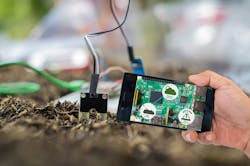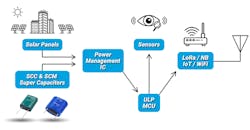Harvest energy from sensors for reduced maintenance and improved safety
A Control Design reader writes: Our new companywide initiative is challenging us to reduce energy and our carbon footprint. A wireless sensor network powered with energy harvesting seems like it might have potential. Where might we implement energy-harvesting sensors for factory automation, measurement, including process variables, and control? What conditions need to be present for energy harvesting, and is it available on all types of sensing devices? What about smart devices with wireless Ethernet connectivity? What functions can we expect from these sensor nodes, and what other benefits do they offer besides power and carbon reduction?
Answers
Wireless sensors and monitoring
There are many places you could implement energy-harvesting (EH) sensors in factory automation and measurement applications. For example, remote or hard-to-access applications that currently rely on physical equipment inspections for status updates could be converted to a wireless sensor network, provided that there is enough energy nearby to capture and that the measurements are sufficient for making an informed decision.
Consider rollers on a conveyor belt in a mining site. These may seem immaterial, but they can slow or even halt production if one roller fails in a hard-to-reach location. Rollers equipped with EH sensors capture the energy generated from spinning and transmit status updates including rotations per minute (rpm), temperature and vibration to enable predictive maintenance, which allows operators to schedule maintenance at the first sign of an impending issue rather than arbitrarily (preventive maintenance) or after a failure (reactive maintenance), both of which can be unnecessarily costly.
There has to be enough energy available for capture to power the circuit, and the circuit must be efficient. Supercapacitors have extremely high power densities compared to batteries, which allows them to deliver and receive large currents and effectively supplement peak power needs.
Efficient circuitry extends supercapacitor battery life, reducing the amount of time, effort and expense required to replace them, which can be considerable in applications such as ocean-monitoring equipment or wind turbines, and reducing battery waste.
Energy-harvesting smart devices require both efficient power delivery and efficient power-off processes. Ultra-low power (ULP) modules address these needs by decreasing the threshold of when a circuit is off, which effectively reduces leaked current or wasted current; operating at very low currents, which makes traditionally low-energy harvesting sources, such RF scavenging, viable; and using very small, volumetrically efficient tantalum capacitors to power the start-up sequence.
Wireless monitoring is a key function of EH sensor nodes, but actions such as closing or opening an electric latch and even powering motors are well within the realm of possibility given supercapacitors’ ability to effectively handle large currents (Figure 1).
The main benefits of EH sensor nodes include reduced maintenance requirements and costs, overall improved safety, and, of course, energy efficiency and carbon reduction. For example, a solar-powered air-quality-monitoring module designed to be installed in vents and equipped with a ULP microcontroller and a supercapacitor storage bank would reduce the power bill, provide timely notifications for filter replacement and support safer working conditions.
Daniel West
lead technical applications engineer / Kyocera AVX
Data diagnostics
From a practical standpoint, I've yet to really see energy harvesting sensors on the factory floor. There may be a few selections out there, but they're not yet common. In the meantime, a better approach may be to work toward energy harvesting that can be recaptured and fed back into a system's power supply.
In terms of implementation, it depends on the energy source and the type of sensor. Certainly you will want to identify sensors and energy sources that are correlated, and, alternatively, you can look for specific environments of a given sensor location that would make it good for energy harvesting. Light capturing, thermal recapturing, electromagnetic energy through RF waves and vibrations are the main technologies behind energy harvesting. I would first look at your plant for any sources of heat and light as the obvious areas to attempt to recapture some of those energies.
With smart devices with wireless Ethernet, certainly the primary benefit is less wiring resulting in cleaner installations. With any device that goes from providing a simple analog or digital value to a smart device, the advantages are the ability to see a significantly higher amount of data on each device. Devices can be configured, process data monitored, and oftentimes preventive maintenance diagnostics are also available. They put more flexibility and power in the hands of the user. Looking down the road toward artificial intelligence (AI), all of this data is useful because it can empower greater decision-making capability in the future.
Paul Anderson
technical manager / Omron Automation
About the Author
Anna Townshend
Managing Editor
Anna Townshend has been a writer and journalist for 20 years. Previously, she was the editor of Marina Dock Age and International Dredging Review, until she joined Endeavor Business Media in June 2020. She is the managing editor of Control Design and Plant Services.

Leaders relevant to this article:


